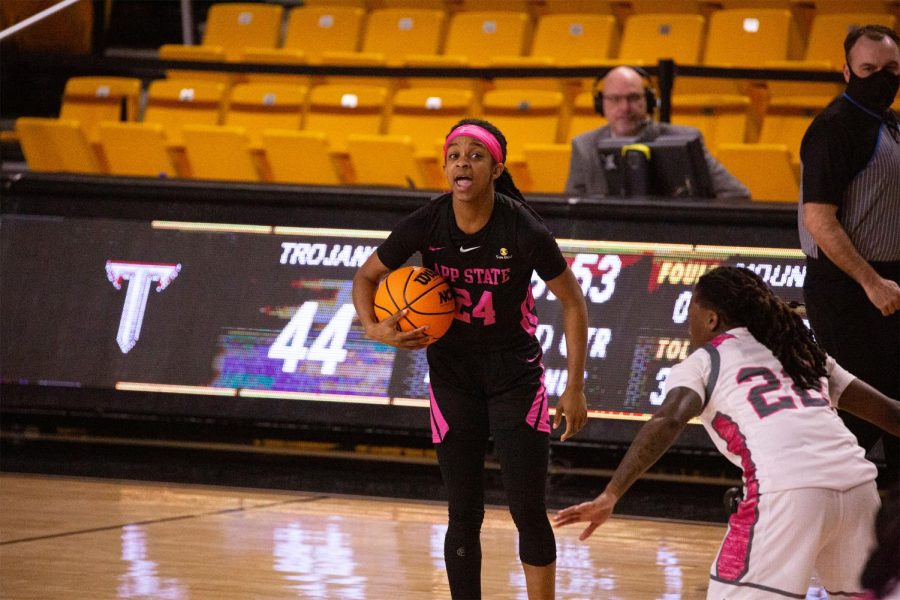Through their eyes: A day in the life of a student athlete
Redshirt senior guard Janay Sanders orchestrates the offense for App State in its loss to Troy Feb. 24, 2022.
November 16, 2022
Six athletes from three different sports gave insights into a day in their lives, shedding light on one of App State’s biggest enterprises — athletics.
In a series of interviews, student-athletes from App State’s women’s basketball, men’s basketball, women’s soccer and football discussed what a typical day in their lives looks like, what it means to be a student-athlete and how they balance the unique expectations placed upon them.
All six athletes said they have played their respective sports from a young age and had the desire to play at the highest level they could — which at this point in their lives is a university setting.
An integral aspect of playing a sport at the collegiate level in the U.S. is stewardship — ensuring that, as an athlete, you positively represent the institution you play for. Athletes across all sports said getting to represent App State as a student and as an athlete “meant a lot” to them.
“We have a saying on my team that the ‘A’ never comes off,” said Janay Sanders, a redshirt senior guard for the women’s basketball team. “Whether you have paraphernalia on or not, people know who you are.”
Sanders used this saying to explain how this stewardship extended to her position as a student as well. Sanders said , as a student-athlete, it is important to show up to class on time, be respectful, participate and sit close to the front to engage with the professor to show commitment to academics.
Each athlete individually emphasized the reciprocity of the term “student-athlete.” Every single student-athlete said you must be a good athlete to compete, but in order to represent the university as a student-athlete, you have to be a good student as well.
All six athletes said their ability to balance athletics, academics and socialization came from careful organization and planning. Across all sports, athletes said they rely on writing things down, making to-do lists and carefully planning their schedules and assignments to stay on track.
Kerry Eagleston, a senior goalkeeper for the women’s soccer team, and Sanders specifically noted the use of a planner. However, all athletes said careful planning of their responsibilities when they receive their schedules every Sunday contributes to their success in balancing responsibilities.
Every individual athlete had a similar schedule irrespective of the sport they played and despite being interviewed separately.
Five out of six athletes said they wake up around 8 a.m. and try to be in bed by 10 or 11 p.m. The notable exception to this regularity was Dashaun Davis, a redshirt sophomore wide receiver for the football team, who said his wake up call was 6 a.m. While individual athlete’s specific class schedules differed, every athlete said they schedule classes, eating time, homework and relaxation with their athletic commitments in mind.
Athletes said these commitments include training, nutrition, recovery and matches, among other responsibilities.
Each athlete said training sessions are a regular part of their week. Five of six athletes said each training session lasts on average about two to three hours, except for Davis’ average five-hour practice session.
Across all sports, athletes said these practices include activities such as weight-lifting, sport-specific drills, rehabilitation and practicing game scenarios. Every athlete said these practices were lighter before a match so as not to risk injury, irrespective of the sport.
Each athlete said this schedule doesn’t change much, even when there is a match. Additionally, athletes said in the event of an away match, teams leave to travel the day before the match.
Every athlete said factoring in travel, practice and “film” in preparation for a match didn’t change their class schedule much, it just required more planning.
In these situations players said corresponding with professors about absences, catching up on their work in long car or plane rides and careful planning helped them stay on top of things.
Required sport-specific activities, such as training, treatment, recovery, etc., takes up about 15-20 hours of their weekly schedule, athletes said. However, this average can increase if the individual athlete decides to spend more time practicing, training, traveling, rehabbing or meeting with psychologists, trainers or nutritionists.
Each athlete said part of their athletic success came from the resources they had access to as a student-athlete. Shannon Studer, a freshman defender for the women’s soccer team, discussed the impact of access to these resources on her athletic performance.
“As an athlete you are expected to do and go above and beyond for the school and keep your grades up while also performing and working out all the time,” Studer said. “So, to have these resources to help you balance that is really important to stay successful.”
Individually, athletes described access to the same resources despite these resources being inconsistently listed under individual team support staff.
These resources include both academic and athletic resources. These are included but not limited to academic advisors and academic coaches, nutritionists, trainers, sports psychologists and robust coaching staff.
Every athlete interviewed said they felt well supported by access to these resources, and the individuals who administer them — including coaching staff, family, professors and other students.
Sanders, who said she feels supported by these resources, said App State Athletics and athletics departments everywhere could still make improvements.
“I’m a Black female, and not many people look like me in the athletics department,” Sanders said. “Having someone that does look like me is very important.”
Sanders said a recent hire on the sports psychology team who does look like her was a step in the right direction to supporting student-athletes of color.
Each of the six athletes said prior planning was important to success, but each student also said that time for relaxation was integral to success. Sanders and Davis both said they engage in yoga and meditation as a way to stay mentally fit, while every athlete said that hanging out with friends was a good method of decompression.
Forms of relaxation differed from athlete to athlete, but popular responses included watching television, speaking with family and playing video games. Each athlete individually said that it was necessary to make time for relaxation in order to perform as an athlete.
Emily Carver, a sophomore guard for the women’s basketball team, said rest was an integral part of performing well as an athlete. Carver also said adequate rest helped athletes avoid injury, in addition to performing well.
Student-athletes face challenges distinct from the experience of the general student body. Almost every athlete said that pressure, hectic travel schedules, missing class and physical repercussions were unique challenges that they thought other students might not understand.
However, it is important to remember the resonance in the collective student experience — athlete or not. Christopher Mantis, a sophomore forward for the men’s basketball team, expressed this sentiment well.
“Everyone faces their own battles,” Mantis said. “I can’t say that what I’m doing is harder than what someone else is doing … so I would say I’m no different from them.”
The specific challenges student-athletes undergo are unique to being a student-athlete, as evidenced by viewing a day in their lives. However, through Mantis’ idea, we are reminded that there is a resonance in the way we as people experience challenges whether or not they are the same challenges — student-athletes or not.













